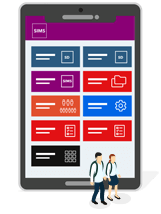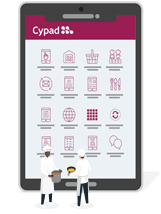Communication with parents in schools is an ongoing challenge for most, with many barriers to overcome. But it’s likely to be high on your school’s list of priorities, as the benefits of effective communication are clear.
Regular, open, and honest communication is essential for building effective two-way parent communication and improving your parent engagement.
Ultimately, parents need to be updated on a number of things, including but not limited to:
- General policies
- Quality standards
- General updates
- News & announcements
- Updates on their child’s learning
- Urgent comms if their child has an accident or gets ill at school
Carefully consider which of the communication channels you have available to you are best suited to each of these types of communication, rather than relying on one channel to deliver all messages.
Remember, there’s no one size fits all approach to parent communication. We recognise that choosing the best channels can be overwhelming, and you need to be realistic about your resources.
To support you with this, we’ve pulled together a list of the best channels for effective communication with parents in schools. We’ve also covered some top tips on how to utilise each of these channels for engaging parents.
What’s more, you can download a copy of our free ‘Ultimate Guide to Parental Engagement‘ to discover everything you need to improve parental engagement in your school.
Top Channels for Parent Communication: and How to Best Utilise Them
Channel 1 – Email
Email lies at the heart of any good strategy for effective communication with parents in schools.
In short, emails are free and easy to send and can be a great way to get in touch with your parents. However, when sharing sensitive or time-critical information, consider contacting parents by phone or SMS. This way, you can reach them more directly.
Most email providers will allow you to schedule email sends in advance. Scheduling email comms for the next month or term frees up valuable admin time, giving you more time to deal with any urgent messages that might crop up.
You also have the option, with most email providers, to create and save templates.
To create templates, start by identifying the type of emails you send most frequently. You can then edit these templates when required – a real timesaver!
Rather than editing them manually, you can also use tools such as Mail Merge to populate and personalise your templates.
While email is a great tool, there are a few things you should consider when using it as a channel for communicating with parents:
- Aim for quality over quantity. Be mindful of the volume of communications you’re sending to parents. If you’re sending too many emails, you’ll likely see a drop in the open and engagement rates. As a result, important messages may go unnoticed.
- Creating and maintaining an accurate database of email addresses takes time and resource, but it’s an essential step. Try making this one of the first goals of your communication strategy.
- It’s easy for an email to get trapped in spam or lost in a busy inbox. One way to avoid this is to get parents to add the school’s email address to their favourites. This will prevent your messages from getting lost in inboxes.
- Consider using other channels when sharing sensitive, important or time-critical information. Such information is often better shared via the telephone or SMS as this doesn’t require parents to check their emails.
- You may wish to invest in paid email software such as Mailchimp, which gives you in-depth engagement statistics.
Channel 2 – School Newsletters
Newsletters are a great channel for effective communication with parents in schools. While they can take a little time to create initially, it’s well worth it.
School newsletters allow you to communicate important messages and updates in a single document – instead of sending multiple emails.
Better still, you can share them via multiple channels for maximum impact. Aside from email, you can print and post them to parents who aren’t in your mailing list. And you can also add them to your school’s website.
Newsletters are also great for sharing a wide range of information. For example, your newsletter may include important updates, student success stories or even charity initiatives.
Where possible, try to prevent important information from getting lost in the noise. If you’re using a newsletter to share critical information, you may want to consider following up with a dedicated communication relating to that message. This ensures everyone is on the same page.
To save on time, consider creating a newsletter template, which you can then simply edit each time you want to send a newsletter out. There are lots of free online tools to help you with this. Canva, for example, offers a range of templates that you can customise. The system is very user-friendly, and no training is required.
You may also choose to translate newsletters into native languages to overcome barriers to engagement. First, you’d need to decide which languages you need to include. You could do this by conducting a parent engagement questionnaire.
Channel 3 – Face-to-Face or Virtual Meetings
Despite technological advancements and several alternatives being available, many people still value face-to-face meetings.
The COVID-19 pandemic has seen traditional face-to-face meetings replaced with virtual meetings that are held using software such as Microsoft Teams and Zoom.
For many schools, parents’ evenings have also moved into a virtual setting over the few years. Systems such as SchoolCloud’s Parents Evening Software have allowed schools to manage their bookings online. With many seeing very promising results from it.
But as the demand for traditional face-to-face meetings will return, there is still be a place for virtual meetings and parents’ evenings to accommodate parents’ and carers’ needs.
Continuing to offer virtual options for face-to-face meetings will keep meetings accessible for parents who perhaps struggle with childcare or leaving home due to illness.
And while in-person meetings may be underutilised in the future, they are still a worthwhile part of any school’s communication strategy. Especially for those challenging and sensitive conversations, such as conversations about a child’s behaviour, progress, or absences.
If you’re concerned about your message being misinterpreted when sending digital communications, consider having an in-person conversation instead.
Channel 4 – Phone & SMS
Communicating with parents via phone call or text message is highly effective. But it can also be costly – both in terms of base costs and the admin associated with them.
With this in mind, consider having a strategy in place when deciding which channel you want to use.
Ultimately, highlighting low priority messages via text/SMS message can make parents switch off.
Consider saving these channels for emergency and high priority communications. This will signal the importance of your communications meaning parents are more likely to pay instant attention.
This is also sensible from an operational perspective as it saves your school money.
In short, text/SMS messages can be costly, so you should be strategic and only use the channel when you really have to.
Channel 5 – Your School’s Website
Be sure to promote and update your website regularly. You need to let people know how they can access your site and what kind of information they can find there.
Consider your school’s website as a self-service portal for parents to find all information relating to your school. It should be a place that your parents can go to get their questions answered, helping to reduce the demand on your admin staff.
A blog can be a great place to explain updates on policy or celebrate the success of your school, students, or staff.
And don’t forget to ensure your school’s site is responsive and optimised for mobile and tablet.
Channel 6 – Your School’s Social Media Accounts
Social media channels are great for communicate urgent updates, such as school closures. But bear in mind: not all parents will be on social media. Like all other channels, it’s best used in combination with others.
When thinking about using social media for your school there are 3 key things you should focus on:
- Sharing relevant and engaging content – plan what kind of content you are going to post and share and how often you are going to post.
- Growing your audience – think about how you are going to get parents from your school to follow your social media channels.
- Encouraging sharing – this can help you to grow your audience and reach parents who aren’t yet connected with you.
There are a vast array of social media channels, each with its pros and cons. The ones that you may want to consider including in your communication strategy are:
Each of these social media channels have their own unique audiences. And different types of content that work best on them. But, in general, social media is great for sharing short messages, updates, and images. You can also link your posts to lengthier updates on your school’s website.
Examples of content that you may want to share on social media include:
- Wins, success stories, celebrations and news
- Key date reminders
- Important updates during crises
- Sharing resources
- Linking to blogs
- Running polls to get information and insight from parents
To save time, consider scheduling posts in batches in advance. You can also use a social media management tool to reduce admin. Free tools include Hootsuite and TweetDeck.
Channel 7 – Posting Letters Home
While everything in the world is moving towards digital, not all parents have email accounts or smartphones. So, including traditional offline communication in your communications strategy is key.
While handing out printouts for children to carry home in their book bags can save you money, it can also be ineffective. Letters can become lost, damaged or left unnoticed until long after the event or deadline has passed.
Paying the money for postage can ensure your letters make it into the hands of your parents.
Printing and postage can be expensive, so consider using digital channels wherever possible. Encourage parents to sign up or consent to receiving communications via channels such as email and social media.
You can then identify the parents you don’t have an email address for or that don’t have an email address and send communications to these parents via post.
Channel 8 – Parent apps
Mobile apps are a popular way to communicate with parents in schools. And it’s easy to see why. Parent engagement apps allow you to manage your school operations via one powerful platform.
Parent apps such as School Gateway simplify parent communication, offering online reporting and two-way app messaging. This way, your school can significantly reduce paper and, in turn, printing and postage costs.
Tools such as Schoolcomms allow parents to access communication, clubs, parents’ evenings, meals and more – from any location, any device. Giving them instant access to their child’s life at school.
With parents, schools can also send push notifications. Push notifications are clickable pop-up messages that appear on a user’s device in a similar style to a text/SMS, only appearing for those who have the app installed. This allows you to have all of the benefits of text/SMS – without the costs.
Like text/SMS messages, you need to ensure you are mindful of how and when you are using push notifications. If you’re using them for every communication, you run the risk of frustrating parents, with important messages getting lost in the ‘noise’.
So which channel should you choose?
Unfortunately, it isn’t as straightforward as simply picking the channel you think suits your school’s needs best and then sending all communications this way.
According to Parentkind, you “must ensure that parents from all walks of life are contributing to the school. Failing to do this may result in a skewed understanding of parental opinion”.
There is no single channel that will be successful every time with all parents. That’s why you should be taking a flexible multi-channel approach when developing your communications strategy.
If you use a mix of the channels mentioned above and continue to optimise your strategy, you will achieve effective communication with parents in your school. Continuously monitor your communications, assessing the effectiveness and then adapt your strategy accordingly.
Channels aside, there are many other factors that can improve parent-teacher communication, including putting a strategy in place for constructive parent-teacher communication.
The goal of your communications strategy should be to build and maintain a healthy two-way collaborative relationship, ensuring parents have access to all the information they need.
For more on how to foster and develop meaningful parental engagement, download our ‘Ultimate Guide to Parental Engagement’. This covers everything you need to improve parental engagement at your school for real, positive results.






